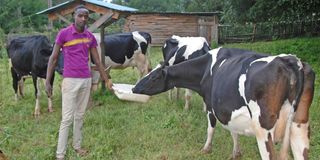Premium
Vet on call: Checklist for setting up a dairy farm

Robert Rono feeds his dairy cows at Tinet Farm in Kuresoi South, Nakuru County. Dairy cattle require lots of feed. An adult cow consumes feed equivalent to 3 per cent of its body weight on dry matter basis.
What you need to know:
- Farming is not like reading a book, which one can put a pause to for a time and then continue later from where he left off.
- It is an ever-evolving engagement where no day looks like the next one. In short, farming is a live activity with a myriad of possibilities every day.
- One also needs to look at availability of key inputs especially land, capital and labour. I have already ticked those aspects.
- The farm requires a perimeter fence and properly planned paddocks. The paddocks are good for grazing the young stock and dry cattle.
Many readers have asked me over time whether I am a livestock farmer. One farmer even told me I should consider running a farm for one livestock species where both practising and aspiring farmers can visit for lessons.
Well, in my earlier life, there were many factors that made farming unsuitable for me. Therefore, I have always answered in the negative.
Farming is not like reading a book, which one can put a pause to for a time and then continue later from where he left off.
It is an ever-evolving engagement where no day looks like the next one. In short, farming is a live activity with a myriad of possibilities every day.
Good news to those who asked me if I would consider doing livestock farming. I am going into it, starting with dairy cattle. I will be sharing my progress periodically as I establish the venture.
I am currently looking at the farming model I will adopt and figuring out the preparations I need to take before stocking.
You see, establishing a livestock farm requires one to have a checklist of pre-requisites. The first one is whether one has the knowledge needed to profitably raise the animals.
Mine is a tick. If one does not have sufficient knowledge, he should consult credible knowledge sources such as livestock health and production experts, successful farmers and written materials.
Availability of key inputs
Another consideration is the geographical area of the farm and its suitability for livestock farming. Mine is okay as it is in Murang’a, a tea-growing area where dairy cattle have done well since their introduction. In addition, the altitude is scientifically known to be highly suitable for all exotic dairy cattle.
One also needs to look at availability of key inputs especially land, capital and labour. I have already ticked those aspects.
he land is well-supplied with piped water, rivers and rainwater. Water is critical for dairy production because a dairy cow consumes 60 to 80 litres of water daily, depending on the state of lactation and the water content in the feed the animal eats. Most cattle produce poorly because of inadequate water intake.
I am also looking at the farm planning. The land is currently unutilised with lots of bush. I plan to clear and fence it, then put up farm structures. Regardless of the farming model I will adopt, there are basic structures that I must put in place.
There is the workers’ housing. I plan to have one resident worker while the others will come only during the day. There has to be sanitary facilities for all the workers and visitors.
The farm requires a perimeter fence and properly planned paddocks. The paddocks are good for grazing the young stock and dry cattle.
I am also looking at putting up the cattle shelters. Even if I choose open grazing, the cows would still need to be sheltered at night due to very low night temperatures.
Feed production
During the day, they may also need to be sheltered from heavy rains that are common in the area.
Dairy cattle require lots of feed. An adult cow consumes feed equivalent to 3 per cent of its body weight on dry matter basis.
This means the quantity of feed after all water has been dried out. Thus, a 500kg cow requires 15kg of feed in dry matter; meaning about 18kg of dry grass.
It, therefore, follows that I have to very seriously plan and implement feed production on the farm. From my assessment, the farm will be able to produce sufficient fodder for my animals. However, quantities alone are not sufficient. I will need to produce feeds that are balanced.
The fodder I produce must contain sufficient proteins, carbohydrates and a large proportion of minerals and vitamins. The two latter dietary components are normally complemented from commercial preparations.
To cater for the carbohydrate and proteins, I am planting Kikuyu and brachiaria grasses and a legume called desmodium. Kikuyu grass is for grazing while brachiaria is harvested.
The grasses mainly provide carbohydrates while desmodium provides protein. It has up to 18 per cent protein.
The number of cattle the farm can hold will depend on the farming model I will finally choose. However, I am very clear in my mind that the farm must be self-sustaining and profitable. I will share the progress of implementation as I continue establishing it.





